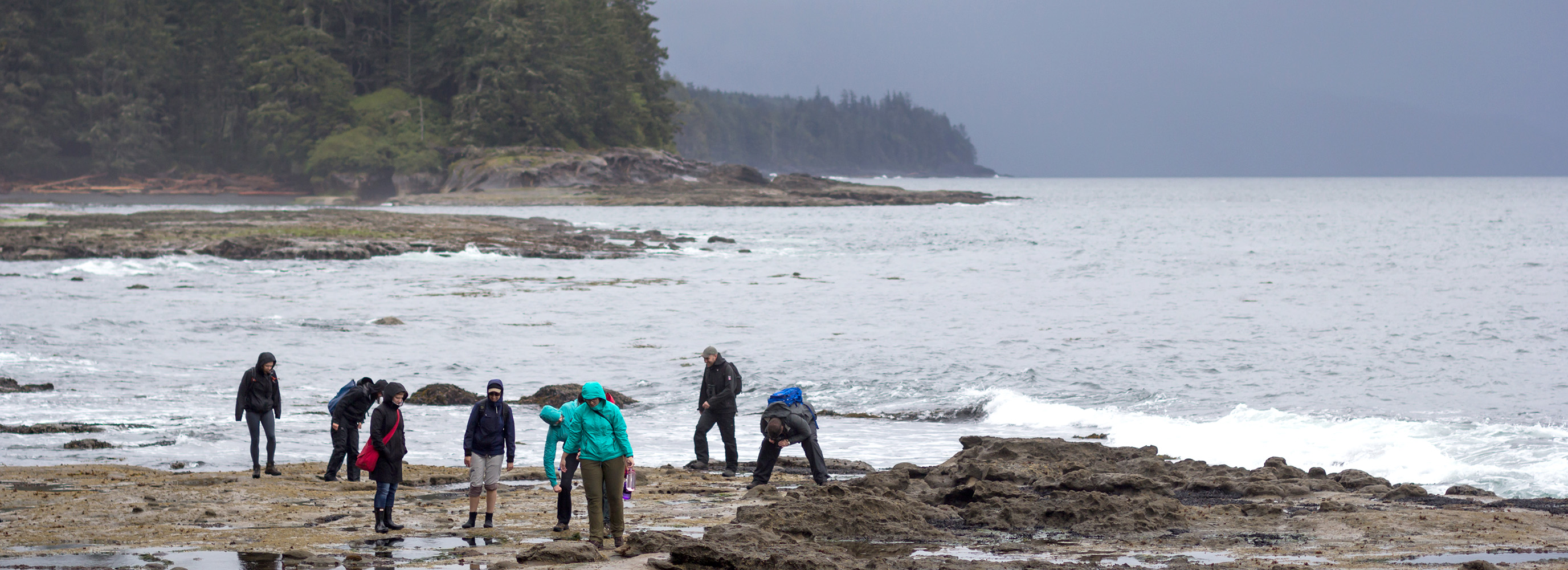The Future of Field Guides
A new phone app makes identifying seaweed easier than ever before.
The grips on your gumboots give way underfoot as a slippery blade of seaweed threatens to plunge you off the rocky shoreline into the cold waters of the Pacific. But what kind of seaweed is to blame? British Columbia has over 400 known seaweed species, in every color and shape imaginable—chocolate-brown and stringy like spaghetti, bubblegum-colored tufts, ruffled lettuce-like leaves that shimmer from maroon to blue.

Thanks to this variety, few people can identify more than a couple of charismatic species. That is, until the recent release of a user-friendly phone app, Seaweed Sorter, co-developed by seaweed biologist Patrick Martone, an associate professor at the University of British Columbia and frequent Hakai Institute collaborator.
“This app feels like a big step forward for anyone who wants to know what seaweed they are looking at on their walks along the shore,” says Martone, who added that traditional scientific identification methods were often inaccessible to most people.
When scientists try to identify an unknown animal, plant, or alga, they often use a dichotomous [die-KOT-oh-muss] key. A dichotomous key is like a flow chart that leads you through a series of questions to the correct species. Does it walk on two legs? Go to question 3. Does it walk on four legs? Go to question 4 instead. But these jargon-filled keys are only understandable to a handful of experts. And even experts have trouble using them.
“Working with dichotomous keys is frustrating,” says Martone. “You get to a question where you have to answer yes or no to move on. But you get stuck if you don’t understand the jargon within the question.”
Seaweed keys are particularly tricky. These algae belong to one of three phyla—red, green, or brown—so the first question in a key is usually, to which of these groups does the specimen belong. One problem: seaweed’s apparent colors don’t always match their group. One species of sea sac appears yellowish, but is actually in the “red” phylum. A similar-colored seaweed, which resembles a deformed cauliflower, is in the “brown” phylum. It’s hard to even make it past the key’s first question.
Like a dichotomous key, the app asks users a series of yes/no questions then suggests what your mystery seaweed may be, including species that are often confused. The app has the added benefit of providing pictures and explanations for difficult terms within the questions.
“I wanted to come up with questions that anyone can answer without needing a dictionary beside them,” says Martone.

Unlike dichotomous keys, you can’t get stuck on a question. If you’re unsure at any step, you can skip a question and the app will take you to another track along the decision tree toward your seaweed’s identity.
Before its launch, Martone tested multiple versions of the app with eager university students taking a seaweeds course he teaches at Bamfield Marine Sciences Centre each fall. The tests revealed surprises.
“That is why it has taken over three years to design,” says Martone. One example is wording: several students could interpret the same question differently. A question as simple as, “is the seaweed bumpy?” could be answered yes by one student and no by another; in other words, a qualitative factor like “bumpy” could be open to interpretation. Martone adjusted or got rid of these trickier questions.
He also designed it for accessibility. Given that many places you can find seaweeds are devoid of internet, the app doesn’t need a connection once it’s downloaded. And while books can get quickly out of date as names change or new species are found, the Seaweed Sorter app will download updates so it’s always accurate.
Martone feels confident in the first publicly available version. It identifies more than 100 seaweed species—most of the ones you’d be likely to slip on in British Columbia, Washington, Oregon, and parts of Alaska and California.
“[Seaweed Sorter] is meant for amateur naturalists, university students, and educators alike,” says Martone.
As of November 2017, the app is only available for iPhones. Martone is working with a developer to have an android version ready early next year. And fret not if you live on a different coast—Martone is already talking to colleagues from Hawaii, California, Chile, England, and the Mediterranean to make versions for their regions too.
“It surprises me how many times, even during the test phase, that I’d pull my phone out of my pocket to show people images within the app,” says Martone. “You can think of the $5.49 it costs as your membership fee for a personalized taxonomist in your pocket.”
The app can be downloaded from iTunes at:
https://itunes.apple.com/us/app/seaweed-sorter/id1141691364?mt=8

